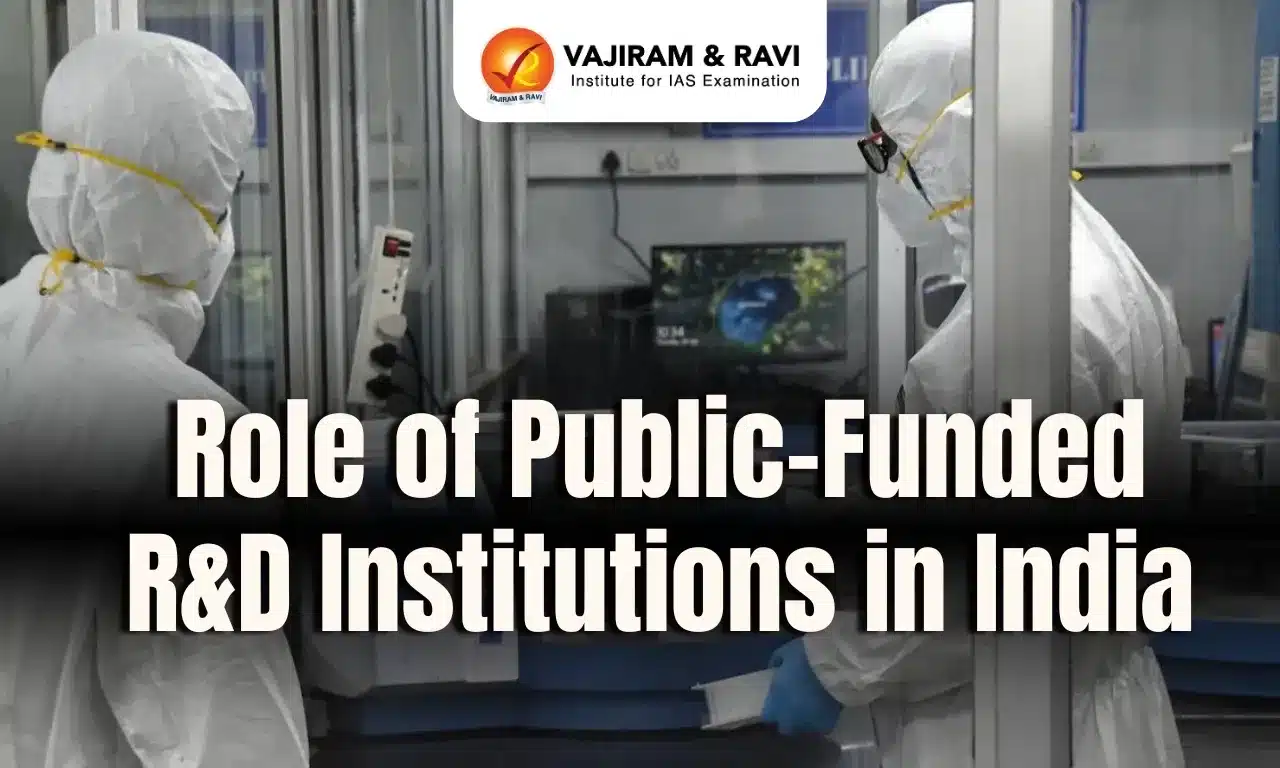What’s in Today’s Article?
- Role of Public-Funded R&D Institutions in India Latest News
- Scope of the Study
- Objective of the Study
- Methodology of the Study
- Key Findings of the Study
- Recommendations of the Report
- Conclusion
- Role of Public-Funded R&D Institutions in India FAQs
Role of Public-Funded R&D Institutions in India Latest News
- A detailed report titled ‘Evaluation of Innovation Excellence Indicators of Public Funded R&D Organizations’ was released by the Office of the Principal Scientific Adviser, CII, and the Centre for Technology, Innovation, and Economic Research.
- It aimed to assess the innovation outcomes and national contributions of public-funded R&D institutions in India.
Scope of the Study
- Institutions covered: 244 public-funded R&D organisations affiliated to various ministries.
- Excluded: Scientific institutions such as those belonging to –
- Defence research and development, space research, and atomic energy research – these make up the dominant share of India’s overall R&D spend.
- Academic institutions and universities.
- Rationale for exclusions:
- Sensitive nature of work in defence, atomic, and space domains.
- Academic institutions not included due to differing mandates.
Objective of the Study
- Core purpose: To examine whether public-funded labs are:
- Engaged in academic (curiosity-driven) science,
- Or aligned with industry-driven innovations and product development.
- Broader goals:
- Contribute to Sustainable Development Goals (SDGs).
- Align with National Missions (e.g., Deep Ocean Mission, National Quantum Mission).
- Support women scientists, skilling, and employment generation.
- Guide labs to address socio-economic challenges.
Methodology of the Study
- Survey format:
- Online questionnaire with 62 parameters.
- Labs/institutes self-select themselves as ‘Basic, Applied or Services’ or as ‘hybrid’ (if their research falls into more than one of the first three categories).
- All the data submitted by the labs/institutes was signed off by each lab director to ensure authenticity.
- Key parameters measured:
- Annual R&D expenditure.
- Share of young scientists.
- Number of patents and technologies developed.
- Participation of women scientists.
- Contributions to national missions.
- Collaboration with industry (domestic and international).
- Incubation support to startups.
Key Findings of the Study
- Limited industry and startup engagement:
- Only 25% of the labs surveyed gave incubation support to startups.
- Merely 16% provided support to ‘deep tech’ startups.
- Just 15% collaborated with industry overseas.
- Access and openness: About 50% opened facilities to external researchers/students.
- Contribution to national missions:
- 50% contributed to ‘Make in India’.
- 35% aligned with Skill India.
- 30% targeting the Swachh Bharat.
- Human resource trends:
- Decline in permanent staff.
- Rise in contractual staff from 17,234 to 19,625.
- Young researchers’ share increased from 54% to 58%.
- Women scientists’ representation remained stagnant.
- Budget growth: The combined budget of 155 labs/institutes increased from ₹9,924 crore in 2017-18 to ₹13,162 crore in 2022-23.
Recommendations of the Report
- Mandate realignment:
- All labs to review and align mandates with ‘Viksit Bharat’ vision.
- Prioritise critical technologies on a war footing.
- Strategic collaboration and capacity building: Strengthen partnerships with:
- Industry
- Startups
- Other R&D labs
- Higher Education Institutions
- Institutional reforms: Promote establishment of Section 8 Companies (nonprofit organisations established under the Companies Act, 2013) to –
- Provide support to startups,
- Open research and testing facilities, and,
- Improve cross-linkages with higher educational institutes.
Conclusion
- Strengthening public-funded R&D institutions through targeted innovation, industry collaboration, and alignment with national missions is essential to propel India towards its vision of Viksit Bharat.
- With strategic reforms and inclusive participation, these institutions can become powerful engines driving sustainable development, technological self-reliance, and global scientific leadership.
Role of Public-Funded R&D Institutions in India FAQs
Q1. What was the main objective of the study titled ‘Evaluation of Innovation Excellence Indicators of Public Funded R&D Organizations’?
Ans. The study aimed to assess whether public-funded R&D labs in India are contributing meaningfully to innovation and national development goals or are primarily engaged in academic science.
Q2. Why were institutions under defence, space, and atomic energy excluded from the study?
Ans. These institutions were excluded due to the sensitive and strategic nature of their research activities.
Q3. What key recommendation did the report make regarding alignment with national goals?
Ans. The report recommended that all public-funded R&D organisations must realign their mandates to support the vision of Viksit Bharat and focus on critical technologies.
Q4. What was a significant finding regarding industry and startup collaboration?
Ans. Only a small fraction of labs (25%) supported startup incubation and even fewer (16%) supported deep-tech startups, indicating limited industry engagement.
Q5. What human resource trend was observed in public-funded R&D institutions in recent years?
Ans. There was a decline in permanent staff and an increase in contractual staff, alongside a modest rise in the share of young researchers.
Source: TH
Last updated on January, 2026
→ Check out the latest UPSC Syllabus 2026 here.
→ Join Vajiram & Ravi’s Interview Guidance Programme for expert help to crack your final UPSC stage.
→ UPSC Mains Result 2025 is now out.
→ UPSC Notification 2026 is scheduled to be released on January 14, 2026.
→ UPSC Calendar 2026 has been released.
→ UPSC Prelims 2026 will be conducted on 24th May, 2026 & UPSC Mains 2026 will be conducted on 21st August 2026.
→ The UPSC Selection Process is of 3 stages-Prelims, Mains and Interview.
→ Prepare effectively with Vajiram & Ravi’s UPSC Prelims Test Series 2026 featuring full-length mock tests, detailed solutions, and performance analysis.
→ Enroll in Vajiram & Ravi’s UPSC Mains Test Series 2026 for structured answer writing practice, expert evaluation, and exam-oriented feedback.
→ Join Vajiram & Ravi’s Best UPSC Mentorship Program for personalized guidance, strategy planning, and one-to-one support from experienced mentors.
→ UPSC Result 2024 is released with latest UPSC Marksheet 2024. Check Now!
→ UPSC Toppers List 2024 is released now. Shakti Dubey is UPSC AIR 1 2024 Topper.
→ Also check Best UPSC Coaching in India

















